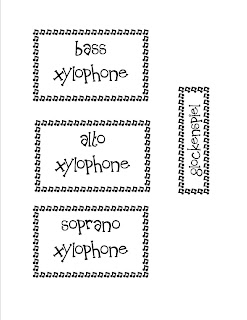Tips for Differentiating Instruction in the General Music Classroom
Don’t fret! It’s not
just “something else to do.”
Implementing strategies and activities for differentiated instruction in
your music classroom can be easy, practical, and beneficial for students. A classroom that uses differentiated
instruction simply works to meet the needs of its students. Differentiating instruction might look like
centers or independent projects or small group work. It might involve taking student surveys to
find out what they are interested in.
The bottom line is that differentiated instruction in any classroom is
simply meeting the needs of individual students.
For a general music teacher this can sound
over-bearing. We often have hundreds of
students that we see once a week. How
can we possibly meet the needs of all students through differentiated
instruction when we know so little about them?
I certainly won’t claim to have all the answers, but I do
have some simple tips for implementing strategies for differentiated
instruction in the general music classroom.
1. Differentiate one aspect of the lesson in your
beginning stages of differentiated instruction.
Think about the three main parts of your lesson: content,
processes, and products. Give students
at all levels opportunities to experience the content, processes, and products
in ways and at a pace that works well for them.
For instance, an advanced student might be ready to begin composing in
6/8 time while struggling students are still working on 4/4 time. Implementing readiness-level (below-level,
on-target and advanced) small groups would be an easy way for students to
explore rhythm content at a pace that meets their needs.
You might differentiate the processes in which students
learn the content. For example, I use a
lot of small group work, but there are always some students who drift away on
their own. I used to require them to
work together in a group, while, sadly, forgetting that many students are great independent workers. Now I give
students the option to work alone or with others when it’s appropriate. This gives students more choices and thus
helps management, student engagement, and
learning.
Differentiating the products within a lesson generally
allows students choice opportunities in order to show or demonstrate what they
have learned. For example, in the rhythm
lesson mentioned before, advanced students might choose to compose and perform
four measures of 6/8 time while the struggling students might choose to perform
only. I believe it is important to
involve authentic music skills in each lesson, but at times a variety of written
assignments or projects might also be appropriate. For example, my third grade classes are
working on a West African program. I
will probably allow them to choose a writing project towards the end of the
unit that allows them to demonstrate what they have learned in the form of a
letter, speech, short story, or another writing activity. But this will come at the end of a unit
filled with authentic musicking (David Elliott) and dancing.
2. Think about your students learning styles,
interests, and readiness levels.
Because we general music teachers might not be able to
differentiate instruction according to the needs of every student individually, we can at
least provide a variety of activities that reach multiple learning styles,
interests, and readiness levels.
When I teach rondo during a form unit, for example, I really
enjoy allowing students to create their own B, C, D, etc. sections with things
that they are interested in. You can
even create simple ostinati using words or phrases related to student
interests.
Be sure to include the use of multiple intelligences in your
lessons (Howard Gardner). Visual
students will need to see examples of form and rhythm, aural students will
benefit from hearing an example, while kinesthetic learners will benefit from a
simple ABA dance. Don’t be afraid to
integrate math (for the logical/mathematical learner), self-reflections
(intrapersonal), group work (interpersonal), language or lyrics (linguistic),
and the humanities and connections that the arts have to our society and world
(existential/naturalistic). This leads
me to my next point:
3. Get out of your box!
You might already feel like you do that a lot (hopefully I’m
not alone), but differentiating instruction really is all about the kids and
their long-term learning. Add one
strategy at a time and be flexible with it.
Applying differentiated instruction strategies certainly won’t work
perfectly at first (will it ever?), but it does make the classroom a more
welcoming and safe environment as students are allowed to experience failure and
success at their own pace.
Differentiating your instruction should be a natural process
that leads to authentic learning experiences and products. Don’t try to force things that don’t work,
and keep your composure when the music room gets a little louder than you
prefer (or is that just me, too?). A
couple of great resources about differentiating instruction are How to Differentiate Instruction in Mixed-Ability
Classrooms (2nd Edition) by Carol Ann Tomlinson and Making Differentiation a Habit by Diane
Heacox.
Hats off to you as you try differentiation in your music
classroom!
And hats off to me for my longest blog post ever.






This article helped me out a lot. Please keep the suggestion coming
ReplyDeleteLove your thoughts on simple differentiating ideas. The word "differentiate" always burdened my shoulders when teaching but simple changes can give students different ways to learn and succeed. Thanks!
ReplyDeleteGreat article! Wish I knew who wrote it so I can attribute. Am I missing something or is there no author listed?
ReplyDelete